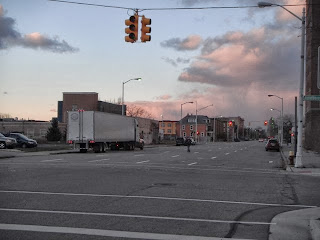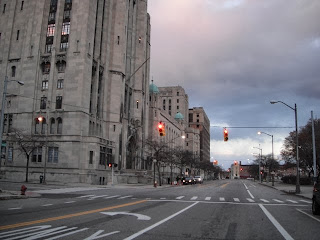Scattered throughout various locations throughout the City
of Detroit, one is likely to run into this sign.
It may be unusual in almost any other urban area, but not
the Motor City. In due time, the
city could end up removing this traffic light at the intersection of Peterboro
Street and Second Avenue altogether.
It stands just a little over a mile from Campus Martius Park, this
absolute center of downtown. But
why would the City’s Department of Public Works consider removing a traffic
light in an area so close to highest concentration of jobs and workers?
It’s not rocket science. This intersection no longer endures the volume of traffic to
justify a stoplight. Or, at least,
the City is pretty sure it doesn’t.
Curbed Detroit featured an article on this assessment much earlier in the year. In many regards, it’s not too
surprising, given the hierarchical importance of these two streets. Second Avenue would most likely qualify
as a collector, an intermediate
street that does not provide the length or support the volume of vehicles that
a more prominent arterial would (such
as Woodward Avenue). Meanwhile,
Peterboro Street is little more than a local
road, just four blocks in length and not intended to handle any major traffic beyond
access to residential quarters. The
Google Map below better demonstrates this relationship.
 Detroiters know that Second Avenue is hardly a street on par
with Woodward, just three blocks to the east; it terminates just a few blocks
to the south, at Temple Street and Cass Park. And Peterboro, the cross street, is only four blocks
long. Considering the built
environment in the area today, its hard to conceive of a time when the density
of commerce and vehicles was ever enough to warrant a stoplight here. But, in many regards, that is the
marvel of Detroit. Here’s a
clearer view of the intersection looking northward down Second.
Detroiters know that Second Avenue is hardly a street on par
with Woodward, just three blocks to the east; it terminates just a few blocks
to the south, at Temple Street and Cass Park. And Peterboro, the cross street, is only four blocks
long. Considering the built
environment in the area today, its hard to conceive of a time when the density
of commerce and vehicles was ever enough to warrant a stoplight here. But, in many regards, that is the
marvel of Detroit. Here’s a
clearer view of the intersection looking northward down Second.
One could make excuses for the general feeling of emptiness,
considering that I took these pictures in the late afternoon on a
Saturday. But judging from the absence
of major buildings flanking either side of Second Avenue, is there any reason
to believe these lanes (all one-way northbound) are ever congested?
Historically, one of Americans’ favorite gripes about their
respective cities is the snarling traffic problem, indicative of streets that
no longer have the capacity to handle the vehicles that pass through. However, even the pro-car
stalwarts (and the Motor City has more than its share) would have to argue that
Detroit’s roads suffer the opposite capacity issue. Simply put, these streets don’t handle nearly the magnitude
of traffic for which their designers originally anticipated and intended.
Both Michigan DOT and Southeast Michigan Council of Governments (SEMCOG) offer reports on Annual Average Daily Traffic (AADT) counts. SEMCOG, with a smaller geographic focus,
also seems to offer much greater detail in its AADT research. For example, this table provides the AADT for Peterboro Street west of Second Avenue, part of the
intersection featured in the above photographs. At 380, the number doesn’t seem that high even without a
comparative context. After all,
this is only a mile from the absolute center of Detroit, and much less from
what would generally pass at Detroit’s downtown. Compare it with the AADT of other street segments of this very minor street and its clear that only two intersections involving Peterboro can even expect
1,000 cars to pass by in a 24-hour period.
But it gets worse.
Compare this with an intersection between a collector and an arterial a
quarter-mile closer to downtown, for example:
This photo looks eastward on Temple Street at the point
where Second Avenue terminates, visible on the left, with the mammoth Masonic
Temple immediately behind it. Just
in the distance are two more intersections with stoplights. The purple circles in the map below indicate
the locations of stoplights on Temple.
It amounts to one of the most excessive traffic light
schemes I’ve seen in any major city center. Because the two segments of Second Avenue are
non-contiguous, they cannot share a stoplight. However, in this instance, not only is the traffic volume insufficiently
heavy to demand stoplights, but the flow of the traffic further weakens the need. In the photo below, I’m standing
between the two intersections (represented by the purple circles to the left
and center on the map), looking eastward.
This stoplight regulates traffic on a segment of Second
Avenue that is just one block long and only one-way northbound. Thus, the light exists only for
vehicles leaving Second Avenue onto Temple Street; cars along Temple can't do anything. Why isn’t a stop sign
sufficient?
The other intersection (the farthest purple circle on the
left) is even more unnecessary.
The stoplight directs traffic between Temple and Second, but
yet again, Second is a one-way northbound street. Thus, a stoplight exists only for vehicles leaving Temple to
turn onto Second; no cars can legally travel the other direction. Since westbound cars on Temple only
need to turn right to enter onto Second, they would not need traffic regulation
under any circumstances. The
stoplight only regulates cars turning left—no other purpose. If these were high-traffic streets,
some other form of management might be useful. But remember what Second Avenue looks like:
Not just a yawning chasm of unused pavement, but a one-way yawning chasm.
I will concede that the Masonic Temple, as a performing arts
venue and meeting space, can bring reasonable crowds when a show or indoor
festival is in town.
But in a city with numerous magnificent theaters, the
Masonic Temple doesn’t really dominate the scene. It rarely hosts an event more than three nights a week, and
while these can get crowded, does a street really need stoplights for just a
few hours here and there? After
all, whether urban, suburban, or rural, one typically expects at least a little
bit of traffic bottlenecking when a major show lets out.
I’m hardly an advocate for high-speed traffic flow
as an easy remedy, especially in urban settings where numerous pedestrians
could be present. But the
conditions for motorists along this stretch of Temple Street are almost
comparable to waiting in line for a ride at Disneyworld. Cars along Temple Street lurch only 100
feet from one stop light to the next, while waiting for absolutely nothing. The lights aren’t timed to expedite
flow, so it is common for a car to stop at all three intersections represented
by the purple circles. Worst of
all: these lights are not under any
study for removal…yet.
This predicament may seem minor in a city that has lost over
two-thirds of its population since its peak (and is continuing to hemorrhage in
most neighborhoods), but it is an inevitable consequence. The lower east side of Detroit, home to
some neighborhoods that have lost over 90% of the population from the 1950
peak, has none of these “removal” signs.
No decommissioned stoplights planned, although the condition of stopping
at lights for no reason is ubiquitous on that side of town.
As a result, the fact that the Department of Public Works’
Traffic Engineering Division is assessing the possibility of removing traffic
lights seems like lemonade out of lemons.
Not only is it good for people getting around by car in the Motor City,
who won’t suffer the inefficiency of stopping at lights that no longer need to
exist (a Pareto optimality under just about any argument that comes to mind). The win-win resolution prescribed here
may seem out-of-touch with the broader concerns of job loss and concentrated
poverty, but any bankrupt city that needs to divest of some of its most fulsome
assets (and their associated operational costs) will inevitably have to
confront the phenomenon of traffic management in an environment that no longer handles
much traffic. Even if the City
sells its tri-color portfolio to fast-growing metros that need them, it will
probably only amount to a drop in the bucket when it comes to reducing some of
the catastrophic debt. But this
strategy is both relatively easy to implement and unlikely to generate the sort
of controversy that one might expect from, say, stripping the Detroit Institute
of Art of its collection. One
final aspiration: that the Department devises a tactic so that a single “study
for removal” doesn’t cost more than the value of the intersection’s stoplights
themselves.













